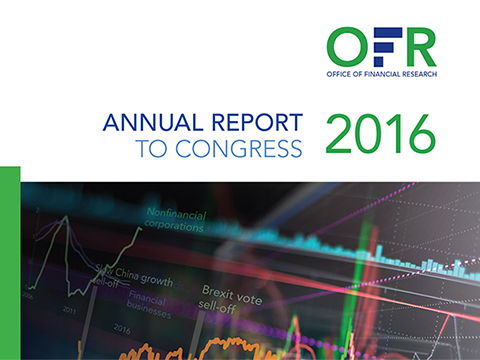2016 Annual Report to Congress
Published: December 13, 2016
This 2016 Annual Report to Congress fulfills our statutory reporting requirements to assess potential threats to the stability of the U.S. financial system, describe key OFR findings and insights, and document our progress in meeting our mission. Our overall assessment — threats to financial stability are in a medium range — has not changed since our report last year, but global events and the evolution of the financial system have shifted the underlying factors. The report also outlines our priorities for fiscal year 2017 and beyond.
Summary
The Office of Financial Research (OFR) 2016 Annual Report to Congress takes the same approach as our report last year. This report meets the statutory requirement to prepare and submit a report to Congress within 120 days after the end of each fiscal year to assess the state of the United States financial system.
The main chapters contain the required content, as defined by the Dodd-Frank Wall Street Reform and Consumer Protection Act of 2010:
- Analysis of Threats to the Financial Stability of the United States
- Key Findings from the OFR’s Research and Analysis of the Financial System
- Status of the Efforts of the OFR in Meeting Its Mission
Analysis of Threats to the Financial Stability of the United States
Threats to financial stability are in a medium range. This overall assessment has not changed since our report last year, but global events and the evolution of the financial system have shifted the underlying factors.
This chapter discusses four themes in our assessment, the interplay among them, and seven threats that apply to them. The chapter also weighs our assessment against the resilience of the financial system and describes our latest Financial Stability Monitor, which informs our assessment along with our research, analysis, and ongoing surveillance. The resilience of the financial system continues to build after the financial crisis of 2007-09, but important vulnerabilities remain and new ones have emerged.
The high-level themes are:
- Disruptions in the global economy
- Risk-taking amid low long-term interest rates
- Risks facing U.S. financial institutions
- Challenges in improving financial data
The specific threats under those themes are:
- Potential spillovers from Europe
- Credit risks in U.S. nonfinancial corporations
- Cybersecurity incidents
- Central counterparties (CCPs) as contagion channels
- Pressure on U.S. life insurance companies
- Systemic footprints of the largest U.S. banks
- Deficiencies in data and data management
Key Findings from OFR’s Research and Analysis of the Financial System
This chapter describes our key findings and insights — what works and what does not for the most effective pursuit of our mission — based on lessons we have learned since the OFR’s inception in 2010.
We have found that interagency memorandums of understanding are essential tools for overcoming obstacles to the appropriate sharing of data envisioned in the Dodd-Frank Wall Street Reform and Consumer Protection Act of 2010. These memorandums set the terms for timely and appropriate access to nonpublic data. We have signed more than 50 of them in the last several years with federal regulators, state regulators, overseas regulators, and others.
We are concerned that, although clearing swaps transactions through central counterparties reduces the risk from the other party defaulting in two-way swap transactions, it also concentrates risk in the CCP itself. After the key findings and insights, this chapter discusses our eight initial programs, which align our priorities with our mission. These programs focus on:
- improving the accessibility, quality, and scope of financial data;
- assessing and monitoring vulnerabilities in the financial system; and
- evaluating policies intended to mitigate financial stability risks and developing tools to monitor emerging risks.
The discussion of the programs includes findings from the OFR briefs and working papers in fiscal year 2016 that relate to the programs.
The chapter also describes our work on shadow banking, which is not part of any single OFR program but cuts across the programs, and the OFR’s role in a public-private project to explore possible alternatives to the London Interbank Offered Rate, a set of interest rate benchmarks known as LIBOR.
Status of the Efforts of the OFR in Meeting Its Mission
This chapter relates how we are working to achieve our mission, including our support of the Financial Stability Oversight Council — a primary purpose of the OFR under the Dodd-Frank Act — and through our wide-ranging collaboration in the United States and internationally. Through this collaboration, we foster a virtual research-and-data community to extend the reach and impact of what our staff can accomplish alone.
The collaboration includes valuable interaction with our Financial Research Advisory Committee, made up of 29 members who are experts and practitioners in fields related to the OFR mission.
This chapter also cites ways we ensure we are transparent and accountable, the governance of our programmatic approach, the continued execution of our strategic plan, and our initiatives to nurture and build our workforce.
The chapter concludes with a summary of our budget and highlights of the information technology infrastructure and safeguards critical to our work.
